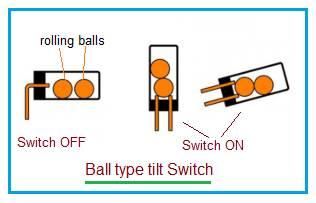Tilt Switch Manufacturers and Basics
This page covers the basics of tilt switches and provides information about popular tilt switch manufacturers or vendors.
What is a Tilt Switch?
A tilt switch is an electromechanical switch that activates or deactivates based on the degree of tilt or inclination.
- The switch becomes ON or OFF based on the degree of tilt or inclination.
- Tilt switches come in various types.
- The most common types are mercury tilt switches and ball-type tilt switches.
- In a mercury switch, a blob of mercury makes contact within a glass bulb.
- In a ball-type tilt switch, rolling balls are used to make contact with the leads.


Figure 1 depicts both mercury-type and ball-type tilt switches.
Tilt Switch Features
The following are the key features of tilt switches:
- Contact Capacity: (e.g., 0.3 A, 24V AC or 24V DC)
- Number of Axes: Determines the tilt direction.
- Operating Angle: The angle at which the switch makes contact.
- Return Angle: The angle at which the switch breaks contact.
- Maximum Forward Current
- Tilt Switch Type: (Ball type, mercury, etc.)
Tilt Switch Manufacturers
The following table lists popular tilt switch manufacturers or vendors:
| Tilt Switch Manufacturers | Description |
|---|---|
| Comus Global | • Model: CW1300 • SPST, Through Hole • Ball type |
| Panasonic | • AHF22 (tilt sensor) • Differential angle from 25 to 60 degrees. • Current 19mA • Surface mount type |
| Parallax | • Model: 28036 • 4 directional tilt sensor • 6 pin DIP for surface mount application • requires 3 to 5.5 VDC • Provide 2 pin output (either high or low) |
| RS Components Ltd. | • Mercury and Non-Mercury tilt switches in various specifications are available. |
 RF
RF

